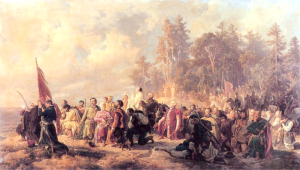
The Bar Confederation, established by Polish nobles on 29 February 1768, was one of the first attempts to defend against Russian interference in Poland’s internal affairs. It had been preceded by the entry of a 20,000-strong corps of Russian troops across the borders of the Polish Republic in 1767, under the protection of which religious dissenters formed confederations to defend their political rights, granted to them by the will of Empress Catherine II.
One of the reasons for the formation of the Bar Confederation was the desire to defend the Catholic faith and the sovereignty of the Polish Republic. It was preceded by an incident involving the kidnapping and deportation to Kaluga of four senators on the orders of Empress Catherine II. This was probably the first politically motivated deportation of Poles deep into Russia. The Confederates, by starting a civil war, also declared war on Russia and attacked tsarist troops stationed in Poland.
Some 100,000 confederates fought on the side of the confederates in the battles. As a result of the collapse of the confederation (1772), several thousand confederates (noblemen and officers) were taken prisoner and deported deep into Russia, including to Sybir. Some of them were conscripted into the tsarist army, among other things to serve in Siberian garrisons; some were settled to start farms or exiled to the Nerchinsk mines, while others built Siberian fortresses in Tobolsk, Tomsk and Orenburg. Some were allowed to return to Poland after Catherine II’s decree (1773), but this did not include those conscripted into the army, those working in the mines, and those who had converted to Orthodoxy. Several hundred exiles from Tobolsk were accused of involvement in the peasant revolt of Yemelyan Pugachev (1773-1775) and were treated like criminals: tortured, had their nostrils torn out, gallows burned onto their foreheads, and shackled for the rest of their lives. Józef Kopeć, a Kościuszko Uprising general who found himself in Siberia twenty years later, recalled: “on my way to Irkutsk, I passed a great many colonies, the inhabitants of which are Poles, considered dead by their fellows.”
Illustration: The Bar Confederates pray before the Battle of Lanckorona by Artur Grottger, 1863, source: Public Domain.



